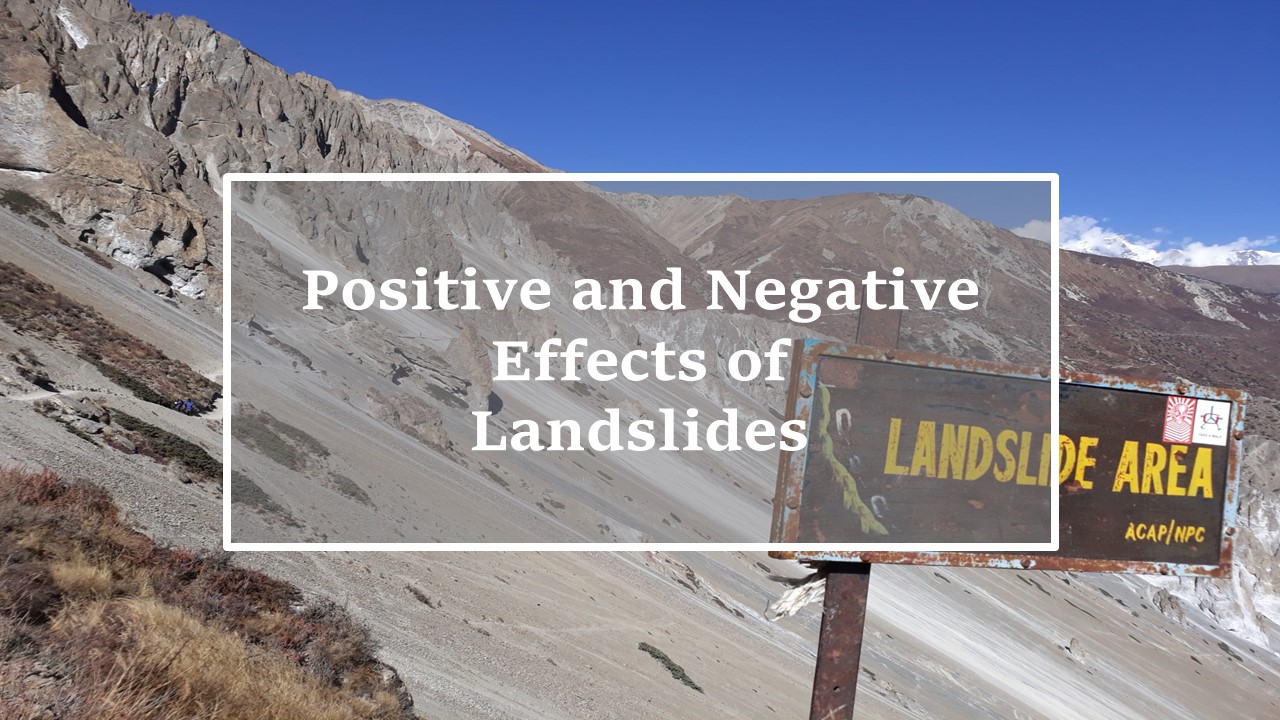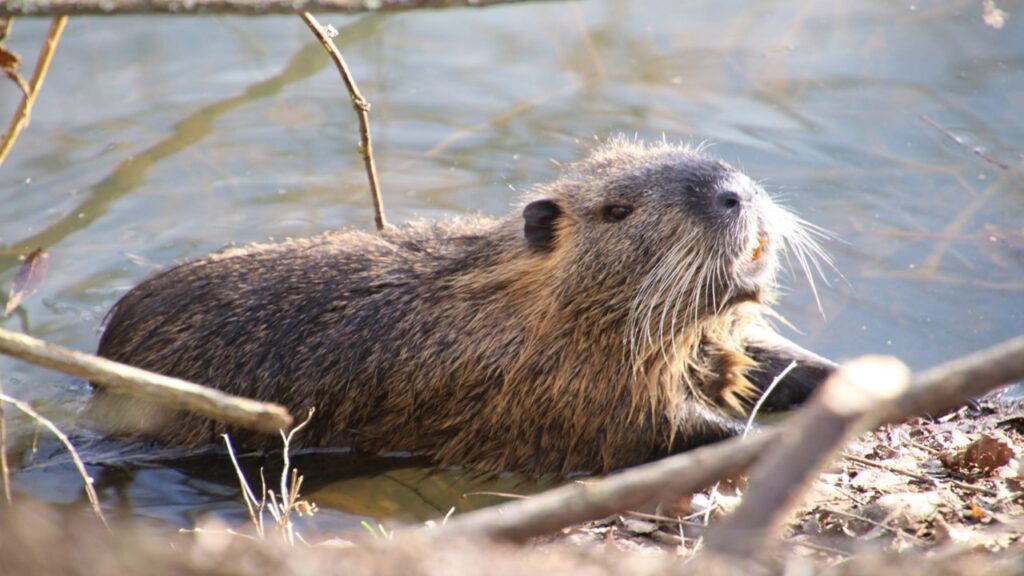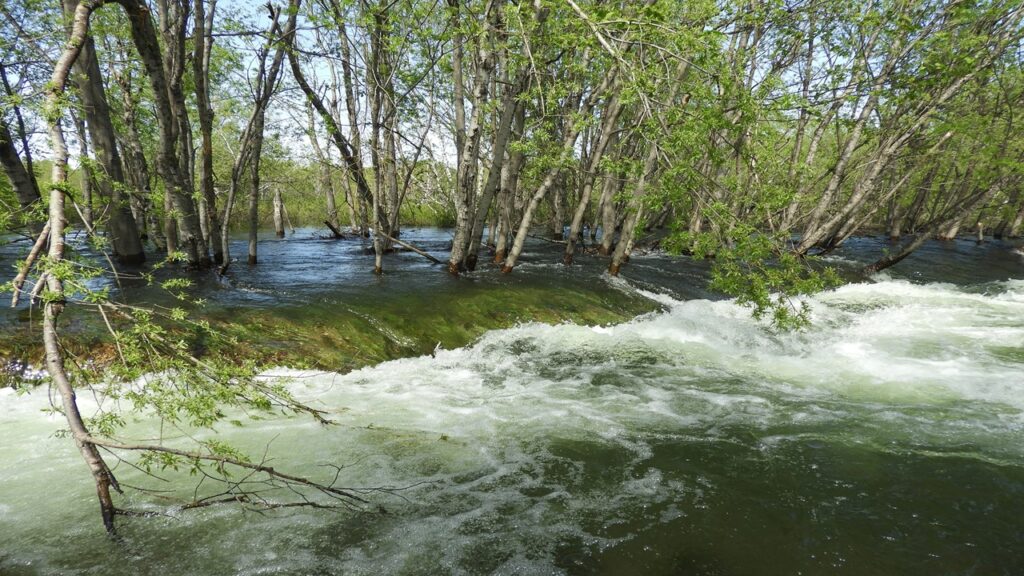Effects of landslides: Positive, Negative, Examples
Posted on August 18, 2020 by Yonature

Effects of landslides can be both positive and negative.
Landslides have affected humans since they have inhabited mountainous regions. Sometimes landslides create opportunities for us. At other times, they are quite devastating.
Why do people live close to landslide-prone areas?
Generally, humans settle in landslide-prone regions because of fertile land and water sources. Additionally, hills, mountains and cliffs provide wonderful aesthetic views. At times, the population can be unaware of the potential dangers or cannot afford safer locations. Many poor communities in Brazil and Venezuela inhabit slopes as they are cheaper. Due to these various reasons, many lives are lost and infrastructure is damaged when landslides occur.
Positive effects of landslides
As with all natural hazards, landslides offer some important service functions. Thus, the positive effects of landslides are: creating new habitats, increasing biodiversity, providing raw materials and can be good tools for studying the environment.
Create new habitats
One of the most important beneficial effects of landslides is that they create new habitats. When landslides occur, they obviously change landscapes. In this way, many micro-environments like hummocks (hills) and ridges form. These features can be warmer, drier, wetter, more exposed, less exposed, muddier etc. than the surrounding regions. Very often, repeated debris flows and slides can deepen gullies resulting in expanded water flows. Like so, new habitats form.
Increase biodiversity
As these new habitats result, biodiversity in that particular region can also increase. It provides opportunities for organisms to colonize the slide sites and grow or survive. For example, slides with ridged topography often form ponds. Sometimes, beavers colonize these sites and create beaver ponds. At other times, cliffs appear during landslides. Cavity nesters like kingfishers and bank swallows can thus inhabit these cliffs. Rodents may also find better habitats hiding under the debris of landslides. What’s more, in New Zealand, kauri trees grow preferentially on landslides scars.

Provide raw materials
Firewood and medicinal plants
Landslide sites can also provide various raw materials be it in the aftermath of a slide or years later. For instance, in Nicaragua, residents of small farms extract fallen Jamaican nettle trees from slides for firewood. In India, indigenous populations harvest medicinal plants such as Nardostachys grandiflora from landslides.
Game and berries
Furthermore, as plants eventually shoot up in the slide site, they attract animals. Hunters can thus pursue wild game to the productive land. Berry pickers can also harvest from these regions, as well as those looking for firewood, decorative or medicinal plants.
Minerals
Similarly, landslides can expose mineral deposits. Over time, mineral grains like gold and diamonds detach due to weathering. They can concentrate at the base of slides or in nearby streams.
Tool for studying the environment
As it is common with disasters, humans can learn from them. Thus, in many instances, landslide sites are good tools for studying the environment. While geologists use landslides to study faults and rock strata, ecologists observe the emergence of plants and their successive growth. Sometimes, bird watchers and scientists may also use these sites for their own studies.
Negative effects of landslides
The negative effects of landslides are: they damage/destroy ecosystems, harm agriculture, damage built infrastructure, lead to economic losses, deaths, social disruption and can lead to other hazards.
Landslides damage/destroy ecosystems
Impact on water quality
When landslides occur, they can seriously damage or destroy ecosystems. Sometimes the effects can last for thousands of years. They can pollute streams and water bodies with sediment and debris. This invariably has severe repercussions on water quality and marine life.
Wipe out forest land
What’s more, these hazards can wipe out large tracts of forests, wildlife habitats and remove productive soils from slopes. In 1960, an earthquake triggered several landslides in Chile which destroyed more than 250 km2 of forest.
Dam up or flood streams
Also, they can dam up rivers and streams. In so doing, water flow is restricted. Marine and terrestrial organisms that depend on the water flow may eventually die. Conversely, dams may flood the opposite side too. Outburst floods can introduce a tremendous amount of new sediment into streams. Or they can submerge and kill vegetation in the flooded region.

Landslides harm agriculture
One of the most damaging effects of landslides is the destruction of agricultural land. Debris spread over farms, cultivation and pastures, covering important agricultural land. They destroy seeds, plants, food stocks and grazing land. These lands can remain inaccessible for years ultimately impacting on farmers’ livelihoods. In Guatemala as an example, watersheds collapsed in 2005 due to landslides associated with Tropical Storm Stan. Consequently, farmers were severely affected by this event.
Damage built infrastructure
Landslides can cause serious damage to the built infrastructure. They can destroy and/or damage houses, buildings and infrastructure close to hills and mountains. They block roads, railroads and shipping lanes. In 1980, a debris flow from Mount St Helens volcano filled the Columbia River with more than 34 million m3 of sediment. Cargo ships could not reach Oregon until the sediment was dredged.
Economic losses
As it currently stands, economic losses due to these hazards have been increasing during the past decades. This is mostly linked to increasing development and investment in landslide-prone regions. Basically, landslide costs include both direct and indirect losses.
Direct losses refer to costs of repair, replacement or maintenance of properties and assets affected by landslides. All other costs like loss of agricultural productivity, effects on water quality and reduced real estate values are indirect losses. The devastating 1983 Thistle landslide in Utah, United States, had direct and indirect economic losses on the order of $688 million.
Loss of lives and social disruption
Landslides are responsible for a number of deaths, injury to people, damage to housing, infrastructure and agricultural lands. In the United States alone, some 25-50 people are killed by landslides each year. In Italy, more than 10,000 people died in 840 landslides during the period 1279 to 1999. More often than not, the disasters happen without warning giving people no time to escape.
Sometimes, such events can impact on the mental health of people also; children and youngsters especially at more at risk. Moreover, victims of landslides can develop crush injuries or crush syndrome after they have been rescued from the debris.
Landslides can lead to other hazards
Very often, landslides can trigger other hazards like tsunamis, volcanic eruptions, wildfires and earthquakes. One of the most famous landslides that initiated baffling tsunami waves is the 8000-year-old Storegga submarine landslide off the coast of Norway. Tsunami waves flooded coastlines as far away as Greenland. Similarly, the 2007 landslide in Vancouver, Canada, resulted in the discharge of 3 million m3 of debris into the Chehalis Lake. Several hectares of shoreline forest were destroyed and tsunami waves pulled out trees from the shoreline to a height of 18 m.
References
- Keller, E. and DeVecchio, D., 2015. Natural hazards: earth’s processes as hazards, disasters, and catastrophes. Pearson Higher Education AU.
- Guzzetti, F., 2000. Landslide fatalities and the evaluation of landslide risk in Italy. Engineering Geology, 58(2), pp.89-107.
- Walker, L.R. and Shiels, A.B., 2012. Landslide ecology. Cambridge University Press.
Category: Environment Tags: advantages of landslides, constructive effects of landslides, destructive effects of landslides, disadvantages of landslides, Effects of landslides, harmful effects of landslides, how landslides affect the environment, how landslides are beneficial to us, negative effects of landslides, positive and negative effects of landslides, positive effects of landslides, primary effects of landslides, problems with landslides, secondary effects of landslides
6 Comments on “Effects of landslides: Positive, Negative, Examples”
Leave a Reply Cancel reply
Get News by Email!
Categories
Search
Find Us
contact[at]yonature[dot]com
Site Links
Secure Site
Get News by Email!
Copyright © 2024 · All Rights Reserved · Yo Nature
Theme: Natural Lite by Organic Themes · RSS Feed

It really helps me to write a good essay for landslide and I’m really happy for the simple words used.
my students of engineering geology are ever using such important information. Its good !!
I am using this for a school project and it gives very clear and simple words and explanations.
Hey, Could you help me out a bit? I was wondering if you could recommend some articles specifically on the economic losses caused by landslides? Like factors affecting the national economy concerning the income of people and business and trade? Thanks.
Pingback: Snow Avalanches Explained: Types, Causes and Examples - Yo Nature
Pingback: Flooding Explained: Types, Causes and Examples - Yo Nature